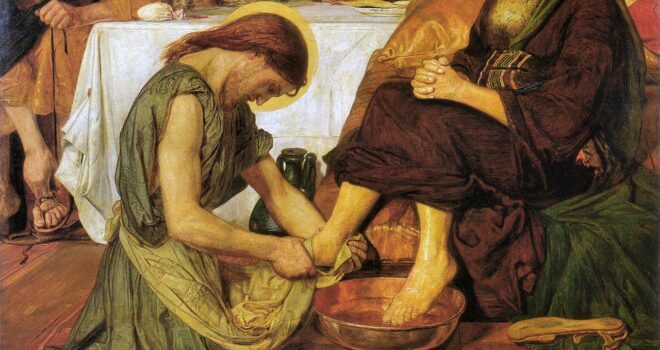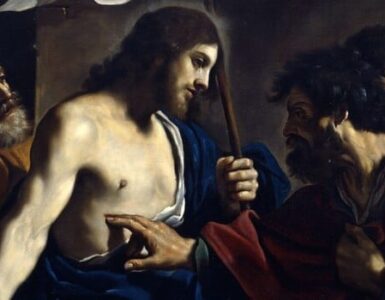The paschal supper might begin at any moment after the appearance of the first three stars; often it began a little later. It is therefore already dark, and the time on that account more propitious for intimate revelations. They will have chosen a lamb, one year old, without spot or blemish. It will have been offered on the altar in the Temple, and it will have been cooked and served in accordance with the rites of which we still find traces in the Mishnah.
While the lamb was being eaten, the head of the family had to explain solemnly, in answer to the question of the youngest child the symbolic meaning of the food set before them. The lamb commemorated the redemption and the salvation of Israel when the angel was bringing death to every dwelling. The mixture of cooked fruits, in its reddish sauce, signified the mortar of Pithom and Rameses during the days of hard labor in Egypt. The bitter
herbs recalled the anguish of those days, while the azyme, or unleavened bread, signified the haste with which their ancestors had fled from the land.
Jesus can invest this teaching with a new significance. He indeed knows who is the Lamb of the true Passover, from what slavery and anguish He is going to deliver us, and what this swift journey is upon which the new Israelites are to embark. They are to pass from evil to good, from spiritual slavery to the freedom of sons, from the kingdom of Satan to the kingdom of God on earth, and from this earth to Heaven. This will be the burden of His speech during the evening.
After the explanation of the rite, a part of the Hallel, or “Song of Praise,” was sung. This was a selection from Psalms 112 to 117, the most vivid passages concerning the Messiah and His sufferings, those which most clearly indicated His redemptive work and its prefigurations in the history of the Jews. The cup was passed around four times. During the intervals the food was eaten, according to rites which varied from Hillel to Schammai (important Jewish rabbis). The last part of the Hallel, a hymn of triumphant thanksgiving to Yahweh, was sung before the fourth cup.
All this was doubtless observed exactly; but the purpose of this final assembly was quite different in reality. The accounts given in the Gospels seem to hurry over the description of the Jewish Passover; indeed, only St. Luke distinguishes clearly between the two stages in the repast. The others mention the Jewish Passover only in connection with the preparations; when they come to the actual meal, they pass quickly over that which was destined to perish, to tell us more directly of that which was to endure.
Jesus, who left to two delegates the task of preparing for the Jewish repast, proceeds now to make His own preparations; and here it is not a matter of house, table, cushions, or provisions. He has to prepare the heart. Wishing to leave a great example of what He has always presented as the sum total of His teaching, and to
interpret beforehand His spiritual banquet in the sense of that unity which He has come to establish, He rises from the table. He takes off His cloak and girds His loins with a cloth. Taking the vessel of water with the basin provided for the ablutions, He kneels on two knees before each of those present, and begins to wash their feet.
Imagine the astonishment of the Twelve at this spectacle! St. John describes the scene in solemn terms upon which Simon Peter’s protest is a sort of commentary: “Lord, dost Thou wash my feet? . . . Thou shalt never wash my feet!” But Jesus,“knowing that the Father has given Him all things into His hands, and that He came from God and goeth to God,” will not be deterred from His task. The evangelist’s account invests the act with a religious and eternal significance.
The symbol of love is mingled with the symbol of purity, so that we may learn that where true love is, there also is the assembly of the saints. Jesus does not need to be purified, but He humbles Himself and He loves. He gives an example of every virtue. By this act He affirms that the enemy of love is pride, and that the enemy of all good is the refusal to love. Humility and charity are the foundation and the crown respectively of the spiritual edifice
which He intends to erect, both in the individual and in the human race. And the Cross, too, which supports this edifice, is as humiliating as it is painful; but when the work is accomplished it will be glorious as the instrument of union and the source of bliss. Everything is there. All is in the Cross, because all is in humility and love, and the washing of the feet is the herald of the Cross.
How they need to be cleansed, these poor feet with which we touch the earth! Even though the head that thinks, the heart that loves, the hands that act may pursue ends which are pure, yet our feet trail in the dust and are soiled by the mud from the road they tread. We need the pitcher of water and the touch of the Savior’s hands. We need submission to cleansing grace if, with Peter protesting and yet converted, we will “have part” in the gift Jesus
brings: “If I wash thee not, thou shalt have no part with me.”
A moment later Jesus shows that the washing of the feet has still another meaning. He speaks of His Apostles, and of the unity that He has come to establish between them and Him, a unity like that between Him and His Father. Jesus washes the feet of the Twelve to prepare them for their journeys across the earth. Purity and humility are the condition of love; and love is the soul of the apostolate. The world will be conquered by those whom Jesus has
convinced that this is the proper order of things, by those whom He has animated with this manifold power.
One might say that He, the divine Apostle, kneels in admiration before these other Apostles whom He is soon to send to the ends of the earth, and who are soon to devote themselves so generously and so effectively to their work: “How beautiful upon the mountains are the feet of him that bringeth good tidings, and that preacheth peace: of him that sheweth forth good!” (Isa. 52:7). The prophet had Christ especially in mind; but what Christ has received He communicates to His own, and there He kneels in humility before the gift from on high.
Resuming His cloak and taking His place once more at the table, Jesus now explains the act which He has performed, and His words are full of exalted teaching. During the whole of this night He pours out His heart in expressions of love, with warnings, too, and sometimes with tender reproaches. Jesus gives to His disciples a complete spiritual testament, especially a testament of love — “a flood of love,” as St. Anselm calls it — and at the same time a torrent of sublimity.
This article is excerpted from What Jesus Saw from the Cross, available from Sophia Institute Press.
Image: Ford Madox Brown, Jesus Washing Peter’s Feet, public domain.










